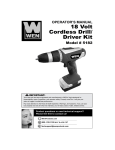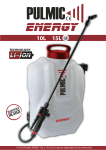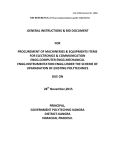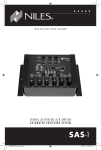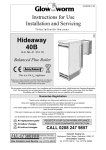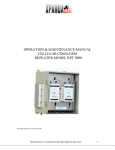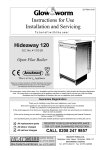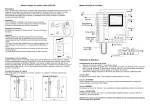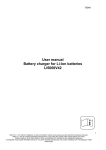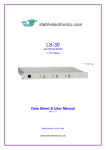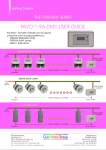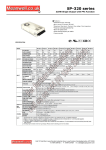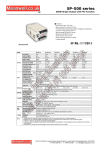Download - Sound Leisure
Transcript
INSTALLATION MANUAL Sound Leisure Limited 39 Ings Road. Leeds. LS9 9EJ TELEPHONE 0113 2175000 (00 44 113 2175060) INSTALLATION PROCEDURE JUKE BOXES Position Jukebox on level ground. If there is no mains power within two metres, arrangements should be made for such a socket. Once the jukebox is sited and various cables have been installed (see cable requirements) unbolt the record play mechanism (The wing nuts are located underneath each corner of the mechanism). Carry out a final check on all cable connections and turn machine on. Check and, if necessary adjust price of play (see credit). Set the pre-set gains on the amplifier to protect the speakers from overload at full volume. Adjust treble and bass to suit. Check all coins give correct amount of credit. Program carousel with records. WALLBOXES Firmly affix the wall hanging so that the coin input slot is of a height that can be reached with ease. The wall box, once hung on the bracket, is anchored with two raw bolts. The holes in the wall box are oversized. This will assist in setting the wall box square if the bracket is misaligned. HIDEAWAY The location of the hideaway is very important. Most hideaway units are located in beer cellars. If the beer cellar has a history of flooding or is hosed down, then it may require raising via a platform and protecting. CABLE REQUIREMENTS 1. WALLBOX A nine-core cable is required. Incorporating three heavy-duty conductors for power and ground, and six conductors of a lighter gauge for data. SPECIFICATION 3 core 6 core 2. Up To 50 metres 1.0mm2 0.22mm2 Over 50 metres 0.5 mm2 0.5mm2 VOLUME CONTROL AND REJECT Four core cables of conductor size 0.22mm2 to 0.5 mm2 3. SPEAKERS Two core cable with index marking of size 0.5 mm2 to 0.75 mm2 CABLE CONNECTIONS WALLBOX A ten- way connector will be found in the Wall box on the small adapter board just below the main computer circuit board. An identical connector will be found in the main unit (Juke box / Hideaway). Both of the connectors are marked 1 through 10 and connection is: 1 to 1, 2 to 2 and so on. Use the heavy core cable on terminals 1, 2 & 10. Terminals 1 & 2 = Power and 10 = Ground. There is a cable entry in the top and bottom of the Wall boxes and at the rear of all Juke Boxes and Hideaways. WARNING! Using a cable of a smaller diameter on Terminals 1, 2 & 10 will cause intermittent or permanent malfunction of the Wall box until the cable is replaced with cable of the correct type. N.B Each Wall box must have one intact single length of 9-core cable running full length back to the main machine. SEE FIGURE 1. WALLBOX CABLE DESIGNATION 1. 14 Volt AC 2. 3. 4. 5. 6. 7. 8. 9. 10. 14 Volt AC Not used* Collector Hold SYNC Pulse B-side Trip A-side Trip SCAN Ground 28 Volt AC centre tap to ground *Although terminal 3 is not used for any Wall box function, at the main Machine terminal 3 is grounded in the play mode and may be used in conjunction with switching kits for other equipment. You may connect up to three wall boxes on a standard machine. VOLUME CONTROLS AND REJECT On receipt of the machine the volume controls will be connected on a short length of cable. The volume control is initially housed inside the machine next to the amplifier. The back of the volume control can be removed to reveal a four way terminal block marked 1 to 4. An identical terminal block is fitted to the amplifier. A four-core cable is required to connect the volume control to the amplifier. VOLUME CONTROL AND REJECT CABLE DESIGNATION 1. 2. 3. 4. Left channel volume Right cannel volume Common* Reject *This is not a permanent ground SPEAKERS Depending on which model machine you are installing, speaker connections are either by means of plug and socket at rear of the machine, or a speaker matching board inside the cabinet. In both situations + and – are marked. All speaker cables should be run back to the main juke box (minimum impedance 4ohms per channel). POWER SUPPLY MAINS INPUT Factory set at 230volts unless otherwise requested. A two metre length of three-core mains cable delivers main to two transformers via an on/off switch. The fuses are located on the mains input box, which also houses the on/off switch. The transformers are housed at the base of the cabinet One transformer supplies 28volts in a 14v-0-14v format This voltage is supplied to the relay board through fuses f2, f3 and rated at 10 Amps. It also acts as the ac supply for the main mpu board. The second transformer has a dual function given its two outputs, 24v ac and 20v-0-20v. The 24volt output is rectified on the relay board by BR1 and smoothed by C4 and protected by a 3.15amp fuse F1, now at 30volt dc this is used by the relay board for relay switching and scan motor control/drive. The 20v-0-20v is fused by F4 and F5 on the relay board and is used to supply the 40vac turntable motor, also 20v-0-20v is rectified by BR2 and taken to plug ‘B’ for the amplifier. MODE OF OPERATION RELAY CONTROL BOARD AND MECHANISM SCAN When terminal 9 of connector strip ‘E’ is grounded this will cause diode D1 to conduct Via resistor R4. The base of voltage at transistor TR1 will be pulled low. TR1 (BC327) will conduct applying 30volts to one side of relay RL1 (Scan relay). As the other end of the coil of relay RL1 is connected to ground via normally closed contacts on MS1, RL1 will energise. When RL1 is energised its contacts apply 30volt via a protection thermistor to a tip3055 emitter follower regulator transistor mounted on the metal back plate of the relay board. A 560ohm pull up resistor is connected between the collector and base of the TIP3055 with an 18volt zener diode holding the base voltage stable at 18volt. The emitter applies approximately 17volt to the scan motor (SM) via the contacts of trip ’A’ relay (RL3). The scan motor applies rotation power through the gear block assembly and spring clutch to the white pulley wheel affixed to the front of the gear block. The scan motor and gear block assembly is mounted on the right hand side of the mechanism. A tension pulley is mounted on the left hand side of the mechanism. A belt skirts the outer edge of the carousel and rides the two pulleys, friction drive rotates the carousel anti clockwise. Figure 2 SYNCHRONISATION AND COUNTING Just To the rear of the operate switch on the mechanism is a metal bracket housing the infrared transmitters and phototransistor receivers. These devices are mounted astride the flange of a metal opto ring fixed to the centre boss of the carousel (transmitter one side and receivers on the other). One pair of devices monitor the inside edge of the flange while the other pair monitor the outer edge. The outer edge of the opto ring flange has a hole drilled at each record location, while the inner edge of the flange has just one hole drilled directly below the record location 100. SYNCHRONISATION As the carousel rotates momentarily infra red light is shone through the hole on the inner edge of the opto ring flange onto the face of the lower phototransistor, as location 100 passes the opto devices. For this short period the phototransistor will go low resistance applying a base voltage to TR7. This will cause diode D11 to conduct momentarily grounding terminal number 5 of the connector block E (the ten way connector). COUNTING Just as with the synchronising opto the counting opto will go low resistance as the infrared light is allowed to pass through the holes of the opto ring. The result of this is that TR4 (BC337) is turned on at each record location. This in turn will allow transistors TR% and TR6 to be turned off. Between each record location TR4 is turned off therefore TR5 and TR6 are turned on causing LED1 to illuminate and D10 to conduct just before each record location. D10 is taken to terminal number 6 of the ten-way connector E which is grounded before each record location. Figure 3 ‘A‘ SIDE TRIP Once the computer has counted to the record location required it will instruct the mechanism to transfer the relevant record to the play position. This instruction is called the trip instruction and is carried out as follows. The carousel is turning and the computer applies a ground to terminal number 8 of the 10 way connector causing D2 to conduct grounding R7 (18K resistor). The carousel will continue to turn until the opto counting device sees the next record location. At this point TR8 is turned on, this turns off TR11 allowing R7 to turn on TR2. TR2 energises the trip ‘A’ relay (RL3), one set of contacts takes TR11 out of circuit while another set of contacts reverse the polarity of the scan motor (SM). The Detent latching coil is connected in series with D9 across the scan motor. As the polarity is reversed the coil is instantly energised, pushing a latch against teeth on the rear of the centre boss of the carousel. The carousel will run backwards to the previous record location where the latch becomes firmly engaged. At this point the spring clutch driving the belt pulley will slip. There is another spring clutch on the gear block, which via a small gear will rotate the camshaft. The various lobes on the camshaft operate the lift arm and clamp arm. A roller underneath the tone arm assembly follows the contours of the left side of the central cam. When the play position is achieved MS3 is operated turning on T10 which keeps the trip ‘A’ relay energised as the instruction from the computer is only of a short duration. MS1 is operated causing the scan relay to drop out and removing power from the scan motor. At this point MS1 applies a ground to the volume control circuit lifting the mute. Trip Circuit Figure 4 Wall box Connections 1 2 3 4 5 6 7 8 9 10 ‘B’ SIDE TRIP Just as with the ‘A’ side trip, the computer will issue a trip instruction. For ‘B’ side the trip instruction is given by grounding terminal number 7 of connector ‘E’, (the 10 way connector). This will cause diodes D8 and D3 to conduct. D3 will turn on TR3, which in turn will energise RL3 trip ‘B’ relay. The contacts of RL3 will energise the ‘B’ side solenoid (BSS ). This is a coil mounted to the left of the tone-arm assembly. Energising this coil will cause its armature to push the tone-arm guide roller to the right through a cutaway in the camshaft, which is uppermost in the standby position. The roller which for ‘A’ sides is normally offset to the left of the cam is now offset to the right. Simultaneously D8 being connected to the same point as D2 will instigate an ‘A’ side trip, but this time as the camshaft rotates the tone arm assembly will follow the right hand contour of the central lobe of the camshaft, selecting the ‘B’ side of the record. TURNTABL MOTOR The direction of rotation of the turntable motor is determined by the turntable-reversing relay (TRR). The far end of the tone arm cradle has an extension arm which closes the ‘A’ side micro switch when it moves to the left to play an ‘A’ side rotation of the turn table motor. For ‘B’ side rotation the turntable-reversing relay does not energise. The turntable motor is a 40v ac synchronous motor. The direct phase is determined by contacts TRR1 on the turn table reversing relay and the 90° split phase by C”, C3. MK11 RELAY CONTROL BOARD Wall box Connections RELAY RELAY RELAY A RELAY POWER SUPPLY PLUG 2 POLE 4 POLE 2 POLE 2 POLE F1 F2 F3 F4 F5 AMPLIFIER PLUG B C D E 1 2 3 4 5 6 7 8 9 10 1 2 3 4 5 6 7 8 9 10 PLUG A PLUG B PLUG C 1 20V A.C. 2 3 20V A.C. 4 12V A.C. 5 6 0V 7 12V A.C. 8 9 24V A.C. 10 11 12 24V A.C. 1 MUTE (A2) 2 3 4 REJECT (A4) 5 6 7 0V (A13) 8 9 10 –20V (A5) 11 +20V (A1) 12 1 M16 2 MUTE (M17) 3 REJECT (M2) 4 5 M5 6 M12 (10OHM 10W) 7 8 9 0V (M1) 10 11 12 M10 13 M13 14 M11 15 M19 PLUG D PLUG E 1 M91 2 3 4 T/TABLE 5 M8 6 7 M,4 8 T/TABLE REV. (M15) 9 10 PULSE IN (M6) 11 12 13 M18 14 (M7) SYNC IN 15 M3 1 W/B 8 2 W/9 3 4 W/B3 5 SYNC (W.B.7) 6 PULSE OUT (W/B6) 7 ‘B’ SIDE TRIP (W/B5) 8 ‘A’ SIDE TRIP (W/B4) 9 SCAN IN (W/B2) 10 0V (W/B1) SERVICE INFORMATION PLEASE NOTE: There are three different types of control units (Relay Boards) used on the Sound Leisure systems. These are known as MK1, MK2 and hybrid, they are not directly interchangeable. The MK1 is fitted to the earlier systems where the turntable is belt driven. The MK1 can be identified by R1 which is a 47 ohms, and capacitor combination C2-C3 which will be either 1 x 10uf or two 4.7uf. The second relay board, part number ACS003 iss2 is a hybrid and could be used with a MK1 or MK2 mechanisms providing the correct resistor R1 and capacitor combination C2-C3 are fitted. The MK2 is fitted to later systems where the turntable is direct drive (Motor pulley driving directly on to tyre on turn table). The part number of this relay board is ACS1002 iss3. Resistor R1 will be 56 ohms and a 4.7uf capacitor will be fitted in position C2 or C2 not both. + 30v C5 GREEN GA1 Y E L LO W GA2 GREY GA3 G3 P IN K GA4 G4 G1 1K D7 100K 100K PULSE D10 COUNT D14 RESET BUTTO N MEMORY HOLD CIRCUIT TR1 BASE +30DC ROTARY CONTROL SWITCH BLACK 'A' SIDE M/SW D5 VIOLET RELAY D.C. 'B' side shift solenoid WHITE D1 TRIP 'B' SCAN OFF PLAY RED C15 T.T REV O PTO U N IT B LU E D13 SCAN G2 M/SW3 TR2 BASE D15 BROWN TRIP BUTTON BLUE REED SWITCH n sca lay e r +30DC C3 AMP MUTING C2 40V A.C. C1 D8 DC RELAY 0V A.C. 8UF 50V D4 GREEN 1 1 M/SW1 YELLOW 1 47R 1 GREY M/SW2 0.22UF F1 1 PINK 1 1 BLUE 1 1 FA3 FA2 F2 T/T MOTOR F3 RED C6 TRIP 'A' RELAY 1 C9 1 BLACK 1 16VO LT SC AN M OTO R 1 C13 IN4004 0.1UF LATCH SO LENO ID VIO LET TRIP 'A' RELAY 1 1 CHASSIS EARTH 30V 30V C12 C13 1 2 3 3 2 1 4 5 6 6 5 4 7 8 9 9 8 7 1 2 10 11 12 12 11 10 3 13 14 15 15 14 13 4 HARNESS PLUG 'C' MALE PINS 2.36 HARNESS PLUG 'D' FEMALE PINS 3.36 HARNESS PLUGS 'F' & 'G' MALE PINS 1.58 CABLE ENTRY VIEW 1 2 3 1 1 4 2 2 HARNESS PLUGS 'Fa' & 'Ga' FEMALE PINS 1.58 HARNESS PLUG 'HA' FEMALE PINS 1.58 HARNESS PLUG 'H' MALE PINS 1.58 TONEARM RELEASE PIVOT TONE ARM TONE ARM RELEASE VIEWED FROM RIGHT HAND SIDE OF MECH TONE ARM CAM VIEWED IN PLAY POSITION RELEASE LEVER RIB AROUND CAM There is no adjustment to the tone arm release lever, except to ensure that the cam stops in the correct position. ‘B’ SHIFT SOLENOID The ‘B’ shift solenoid is mounted through slotted holes allowing a small amount of adjustment sideways. To adjust, slacken off the two mounting screws and push the coil body fully to the left. Then push in the plunger core to the right so that it moves the cam follower to its extreme position and at the same time forces the solenoid body to this position, now re-tighten screws. This method of adjustment ensures that when the cam roller is at its extreme of travel the solenoid is fully engaged. TRANSFER As soon as the scan motor reverse, the drive changes from the carousel to the camshaft via nonreversing clutches. As the camshaft revolves, moving the record and tone arm into position, it operates three micro switches situated on the gear block housing. These are numbered MS1-3 MS1- Closes as soon as the camshaft starts to rotate to ensure that the trip ‘A’ side relay remains energised throughout the transfer cycle. MS-2 Closes as soon as the camshaft starts to rotate to power the turntable motor TM. MS-3 When the camshaft reaches the record play position (half turn from rest), MS1 breaks the ground feed from the scan relay and grounds the amplifier muting circuit to provide audio. The scan relay SR de-energises and the scan motor stops. When either the reject button or the reject reed switch closes the scan relay energises and the camshaft rotates to reject the record. MICROSWITCH ADJUSTMENT Micro switches numbered 1,2 and 3areare operated by cam profiles on main camshaft drive gear and detent lever on gear block (see fig 6). Profile ‘A’ and the detent lever operate micro switches 2 and 3. Profile ‘B’ operates micro switch 1. Only minor adjustments are needed to the micro switches. Make sure that micro switches 2 and 3 are fully closed by the detent lever in the record transfer cycle and fully opened in the scan position. Micro switch 1 can be adjusted by slackening the holding nut M5 on the gear block, and moving the complete switch assembly to the required position. The setting of MS1 determines the stop position of the main camshaft when it plays a record. Note the cam, which operates the record transfer arm. Cam 1 should be set so that the transfer arm roller is in the middle of the small lobe of the cam when its stops. Micro switch 3 determines the stop position of the main camshaft. After operation the carousel either rotates or remains stationary to await the next selection. To adjust the stopping position of the camshaft the following note should be read in conjunction with fig 7. Loosen nut M5 on the eccentric stud located on the top of the gear block assembly. The assembly can then be adjusted by the use of a small screwdriver. Adjust the assembly so that micro switch 3 and 2 opens when the cam operating the transfer arm has maximum clearance from the record magazine when the camshaft stops. A check should be made to see that the cam operating the tone arm has stopped, with the roller operated by the ‘B’ side shift solenoid BSS resting in the gap in the cam (fig 7). Micro switch 2 should operate to stop the turntable motor. When all checks have been made tighten the nut M5 whilst retaining the eccentric stud in the set position. SET MS1 SO THAT CAM SHAFT STOPS IN POSITION INDICATED TRANSFER ARM PIVOT MAIN CAM SHAFT TRANSFER ARM CAM FOLLOWER TRANSFER ARM CAM PROFILE RECORD TRANSFER ARM CAMSHAFT GEAR SHOWN IN REST POSITION MS2 MS3 TRIP BUTTON 'A' DETENT LEVER ARM M5 NUT 'B' CAMSHAFT GEAR C NO MS1 NC CAMSHAFT DRIVE GEAR NON REVERSING LEVER AND LIMIT SWITCH OPERATION The detent lever arm prevents reverse rotation of camshaft gear during scan cycle and also operates MS2 and MS3 during transfer cycle (Profile ‘A’). MS1 is operated by boss (Profile ‘B’) on camshaft gear. CAMSHAFT GEAR SHOWN IN PLAY POSITION MS 1, 2, and 3 OPERATED MS2 MS3 TRIP BUTTON M5 NUT DETENT LEVER ARM CAMSHAFT GEAR MS1 Profile 'A' TRANSFER ARM PIVOT Profile 'B' MAIN CAM SHAFT TRANSFER ARM CAM FOLLOWER TRANSFER ARM CAM PROFILE 'B' SIDE SHIFT SOLENOID ROLLER TONE ARM CRADLE MAIN CAM SHAFT TONE ARM CAM SET CAM SO THAT CAMSHAFT STOPS IN THIS POSITION TURN TABLE MOTOR The direction of rotation of the turntable motor is determined by the turntable-reversing relay TRR. The far end of the tone arm cradle has an extension arm which closes the ‘A’ side micro switch when it moves to the left to play an ‘A’. The ‘A’ side micro switch energises the turntable-reversing relay TRR for ‘A’ side rotation of the turntable motor. For ‘B’ side rotation the turntable-reversing relay does not energise. The turntable motor is a 40v AC synchronous motor. The direct phase is determined by contacts TRR1 on the turntable-reversing relay and the 90º split phase by C2. SETTING UP THE OPTO UNIT The output from the opto unit must correspond correctly with the carousel position. To ascertain this, observe the action of the carousel latch arm ratchet. The pulse L.E.D. should extinguish about haft way along the tooth of the ratchet and energise just before the edge of the tooth. Adjust this position with the screws on the opto unit mounting. The top hole is slotted. When this is correct, reverse the carousel so that it is pushing against the ratchet tooth and ensure the pulse L.E.D. does not extinguish. The output from the opto unit pulse line can be measured at the junction of R24, R25 (TP2) and the sync line at the junction of R28, R27 (TP3). The action is such that when the infra red light beam is allowed to pass through the hole in the opto disc the voltage at TP2 and TP3 should be at least 25V. CAROUSEL LATCH SOLENOID CAROUSEL LATCH ARM SCAN CAROUSEL RATCHET TEETH OPTO RING RECORD 100 101 COUNTING PULSES 102 103 THE EARLY 4 COIN CONTROL AND CREDIT UNIT This is easily recognised, having a pricing card socket across the centre of the board. This board is not equipped with electronic popularity. Facilities such as 140/200 select and random play etc. may be changed by ordering an eprom change from our tech dept. A basic price of play is written in to the eprom and may be overridden as follows. The price of play is selected by wire links on the plug in credit board. The number on the inner row of points correspond with the value of money inserted. The number on the outer row of points correspond with the with the number of credits given. By linking the monetary value to the appropriate number of credits, the price of play is set. There is one point for each monetary value from 10p to 50p and two points for each monetary value from 60p to 100p. For value above 60p it is possible to use two links which sum the credit values up to a maximum of 19. Example: To obtain 14 credits for 90p, link one 90p point to 10 credits and the other 90p point to the 4 credits. Two simple rules must be adhered to when setting price of play: a. b. No two ‘Number of Credits’ points can be linked together. Not more than one link can be connected to an individual monetary value point. Links for 1 ---- 10p 7 ---- 50p 16 ---- 100p Money Value Point No Of Credits Points 10 20 30 40 50 60 60 70 70 80 80 90 100 1 2 3 4 5 6 7 8 9 10 90 100 Links for 1 ---- 10p 5 ---- 50p 12 ---- 100p Money Value Point No Of Credits Points 10 20 30 40 50 60 60 70 70 80 80 90 100 1 2 3 4 5 6 7 8 9 10 90 100 POPULARITY MODE STEP 1 Turn the operate switch on the front of the playing mechanism to the off position. The display will start to flash displaying the least played record followed by the amount of times it has been played. Display STEP 2 1 2 3 4 5 6 7 8 9 0 R KEYBOARD LAYOUT PRESS KEY No 1 The display advances towards the most popular record one location at a time. 2 The display steps back towards the least popular record one location at a time. 3 As Key No. one only ten locations at a time. 4 As Key No. two only ten locations at a time. 5 Instant display of the most popular record. 6 Instant display of the least popular record. 7 8 Reset popularity. STEP 3 PRESS KEY No Display Shows Blank ‘0’ ‘0’ STEP 4 MENU OPTIONS PRESS KEY No 1 Plays for Coins 2 Coins / Meter Pulses 3 Bonus Plays 4 Bonus Pricing MENU OPTION ONE – PRICE OF PLAY STEP 5 KEY No 1 2 3 4 LEVEL 1 LEVEL 2 LEVEL 3 LEVEL 4 LEVEL Number £100 = = = = 10p 20p 50p £1 Number Of Plays Display Press key number for level you wish to alter NEXT :- Press ‘R’ Key NEXT :- Press No. of plays required. NEXT :- Press ‘R’ Key NEXT :- Press key for next level which requires alteration, if any. MENU OPTION TWO – METER PULSES STEP 6 Procedure same as above only substitute No. of plays for No. of meter pulses. EG. Level 3 – 50p Requiring 5 pulses Level Meter Pulses Display MENU OPTION THREE STEP 7 Procedure as above only central and right hand digits will represent No. of plays for each bonus level. MENU OPTION FOUR STEP 8 Procedure as above only central and right hand digits are the price that each bonus addition takes place. EG. 1st Bonus Level at 30p Bonus No Display Starting Price IE 3 = 30p LATER 4 COIN CONTROL & CREDIT UNIT This control and credit unit is far more flexible in its operation than its predecessor. A wide range of functions may be accessed or altered either via the D.I.L. switches, the keyboard, or in some cases a combination of both. D.I.L. SWITCH LISTING D.I.L. SWITCH 8 8 7 7 6 6 5 5 4 4 3 3 2 1 1+2 1+2 STATE FUNCTION ON OFF ON OFF ON OFF ON OFF ON OFF ON OFF ON ON ON OFF PERMANENT FREE PLAY POSITION FREE PLAY INHIBIT POSITION MENU MODE ACCESS POSITION MENU MODE INHIBIT POSITION PRINTER OUTPUT ENABLE PRINTER OUTPUT INHIBIT PRINT CASH + POPULARITY PRINT CASH ONLY 200 SELECT MACHINES ONLY 140 SELECT MACHINES ONLY DISPLAY POPULARITY POPULARITY OFF 15 MIN RANDOM PLAY 20 MIN RANDOM PLAY 30 MIN RANDOM PLAY NO RANDOM PLAY KEYBOARD DISPLAY PLUG 1 2 3 4 5 6 7 8 9 10 11 12 13 14 15 1 2 3 4 5 6 7 8 9 10 11 12 13 14 15 Spare output Spare output Keyboard Strobe K.B.7. K.B.6. 17V D.C. meter/common K.B.5. K.B.3. K.B. Cancel K.B.2 K.B.0. K.B.9. K.B.4. K.B.1 K.B.8. 0V A2 Strobe $5000 A1 A0 Strobe $4800 A3 50p Switch Strobe $4800 +5V 10p Switch Meter Test SW. common Selection playing lamp Select record lamp TERMINAL BLOCK 1 Pulse. 2 Sync. 3 0.V 4 Trip ‘B’ 5 6 7 8 9 10 Trip ‘A’ Scan Memory hold switch 12V 12V 1 13 3 15 3 15 1 13 Display Plug KeyBoard Plug 1 10 Terminal Block MK2 VYNIL AMPLIFIER TREBLE 1 1 2 3 4 VOLUME CONTROL 1. 2. 3. 4. BASS 1 CHANNEL 1 CHANNEL 2 GROUND REJECT TREBLE 2 BASS 2 GAIN 1 GAIN 2 P/U INPUT MK4 VYNIL AMPLIFIER CH2 Ch1 TREBLE 2 TREBLE 1 1. 2. 3. 4. 1 2 3 4 CHANNEL 1 CHANNEL 2 GROUND REJECT MASTER VOLUME MASTER VOLUME BASS 2 BASS 1 AUX VOLUME CONTROL MIC BASS MIC VOLUME CONTROL JUKEBOX INPUT AUX INPUT MIC INPUT THE PICKUP CARTRIDGE MECHANICAL SPECIFICATION TYPE PICKERING STEREO Stylus force Tracking capability Weight Stylus pull out force 4 Grams nominal 15cm/sec 8 grams nominal 8 to 40 ounces ELECTRICAL SPECIFICATION Resistance, d.c. Inductance Load resistance Load capacitance Output nominal Channel separation Frequency response Channel balance Shielding 530ohms nominal 390m, Henries nominal 10,000 ohms 260 Pico farads 1.25mV/cm sec ± 3dB @ 1Khz 16 dB min. @ 1Khz 15hz to 20Khz 2 dB max output difference annealed mu metal case STANDARD PRE AMPLIFIER Number of inputs Input specification Input facility one ( R.I.A.A.) EQ mono SIGNAL The signal is taken through a mono first stage and is split into two mono channels, each with individual treble, bass and pre set gain controls. VOLUME The independent control of each channel is possible via a twin slider volume control. The volume control circuit is of the D.C. type and may be run over long distances without the use of screened cable. Output 2 times 2 volts max MK4 PRE AMPLIFIER Number of inputs Three Input 1 Mic input 1st priority input with automatic voice activated auto fade. Pre set gain control independent treble and bass controls. Suitable for high or low impedance mic’s Input 2 Juke box 2nd priority input (R.I.A.A.) EQ with automatic signal activated auto fade. Mono input split to two channels each with pre set gains, treble and bass controls. Input 3 B.G.M. auto fade in approximately 45 seconds after last record played. Pre set gain control. Input suitable for signal from line level. POWER AMPLIFIER The power output stage is overload protected Frequency range Output impedance Power Output 15 Hz to 100 Khz Flat response 4 ohms min. 60 Watts per channel R.M.S into 4 ohms.































